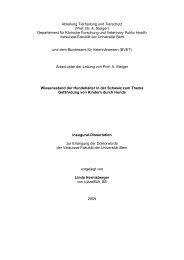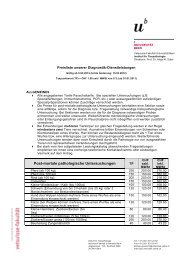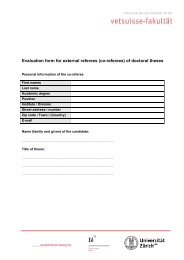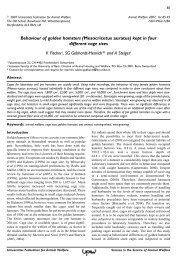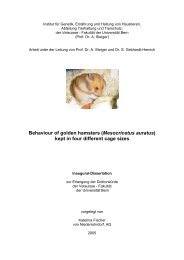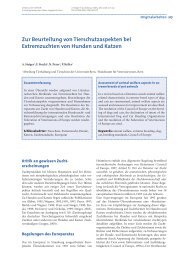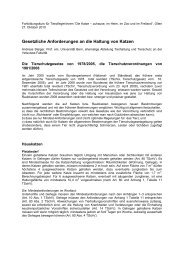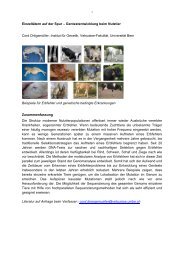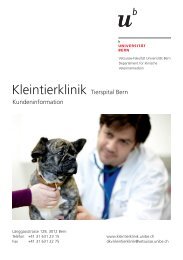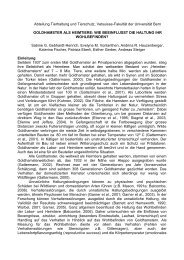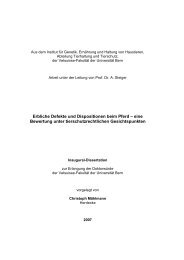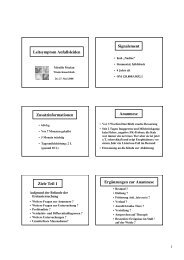Lifespan and Causes of Death in the Irish Wolfhound - Vetsuisse ...
Lifespan and Causes of Death in the Irish Wolfhound - Vetsuisse ...
Lifespan and Causes of Death in the Irish Wolfhound - Vetsuisse ...
You also want an ePaper? Increase the reach of your titles
YUMPU automatically turns print PDFs into web optimized ePapers that Google loves.
Some breeders are currently employ<strong>in</strong>g <strong>the</strong> technique <strong>of</strong> us<strong>in</strong>g frozen sperm <strong>of</strong> dogs<br />
that are known to have lived to a certa<strong>in</strong> age <strong>in</strong> <strong>the</strong> hope <strong>of</strong> <strong>in</strong>creas<strong>in</strong>g <strong>the</strong> lifespan <strong>of</strong><br />
<strong>the</strong> progeny produced. This is an <strong>in</strong>terest<strong>in</strong>g approach, given that it removes <strong>the</strong><br />
uncerta<strong>in</strong>ty associated with <strong>the</strong> use <strong>of</strong> a young stud dog. Aga<strong>in</strong>, its concrete effects<br />
on <strong>the</strong> lifespan <strong>of</strong> progeny depend on <strong>the</strong> heritability <strong>of</strong> longevity, as well as <strong>the</strong> ability<br />
to reconstruct <strong>the</strong> dogs' life medical history <strong>in</strong> order to be able to select for vigour <strong>and</strong><br />
to omit hereditary diseases.<br />
Depend<strong>in</strong>g on <strong>the</strong> heredity <strong>of</strong> lifespan <strong>in</strong> itself, it would be possible to establish<br />
Estimation <strong>of</strong> Breed<strong>in</strong>g Values (BLUP) for lifespan <strong>and</strong> vigour parameters, based not<br />
only on <strong>the</strong> longevity <strong>of</strong> a particular sire, but also on <strong>the</strong> longevity <strong>of</strong> its parents,<br />
sibl<strong>in</strong>gs <strong>and</strong> <strong>of</strong>fspr<strong>in</strong>g. However, <strong>the</strong> chance <strong>of</strong> success <strong>of</strong> this approach largely<br />
depends on <strong>the</strong> heritability <strong>of</strong> lifespan itself, which rema<strong>in</strong>s to be assessed.<br />
Given <strong>the</strong> currently prevail<strong>in</strong>g <strong>the</strong>ory <strong>of</strong> decreased lifespan <strong>in</strong> large dogs be<strong>in</strong>g<br />
caused by an "oxidative burst" dur<strong>in</strong>g <strong>the</strong> rapid growth phase (see chapter 7.1.1),<br />
ano<strong>the</strong>r approach with <strong>the</strong> potential to <strong>in</strong>crease lifespan may be <strong>the</strong> selection towards<br />
a slower growth rate early <strong>in</strong> life. However, <strong>the</strong>re is a chance that this may conflict<br />
with <strong>the</strong> desired end height.<br />
7.4.4 Conclusion<br />
While it will probably be impossible to entirely elim<strong>in</strong>ate every hereditary disease from<br />
<strong>the</strong> <strong>Irish</strong> <strong>Wolfhound</strong> gene pool, it seems feasible to dim<strong>in</strong>ish <strong>the</strong>ir frequency by an<br />
important degree if breeders are will<strong>in</strong>g to select aga<strong>in</strong>st <strong>the</strong>m. It seems likewise<br />
possible to <strong>in</strong>crease average lifespan <strong>in</strong> <strong>the</strong> breed back to <strong>the</strong> levels where it was <strong>in</strong><br />
<strong>the</strong> 1960s if appropriate selection for vigour traits is also <strong>in</strong>cluded <strong>in</strong> breed<strong>in</strong>g<br />
strategy. There is little evidence to suggest that <strong>the</strong> breed<strong>in</strong>g population is too small<br />
for rigorous selection to be possible, but <strong>in</strong>dividual breeders' motivation to use <strong>the</strong>ir<br />
particular bitches <strong>and</strong>/or stud dogs for breed<strong>in</strong>g may pose a problem.<br />
Establish<strong>in</strong>g an <strong>in</strong>ternational open pedigree-l<strong>in</strong>ked health database would be an<br />
<strong>in</strong>valuable means <strong>of</strong> selection to improve health <strong>and</strong> longevity <strong>in</strong> <strong>the</strong> breed, but would<br />
need coord<strong>in</strong>ated <strong>in</strong>ternational cooperation as well as openness from <strong>the</strong> breeders'<br />
part concern<strong>in</strong>g health problems <strong>in</strong> <strong>the</strong>ir dogs. Ultimately, coord<strong>in</strong>ated breed<strong>in</strong>g<br />
efforts imply a decrease <strong>of</strong> personal autonomy <strong>in</strong> selection, which, given its<br />
contradiction to some breeders' <strong>in</strong>terests, will likely result <strong>in</strong> practical problems <strong>in</strong><br />
establish<strong>in</strong>g such efforts. Never<strong>the</strong>less, it currently seems to be <strong>the</strong> only way through<br />
which health <strong>and</strong> lifespan could be potentially improved with<strong>in</strong> <strong>the</strong> breed <strong>and</strong> thus<br />
warrants fur<strong>the</strong>r efforts to be undertaken <strong>in</strong> this direction. As demonstrated <strong>in</strong> <strong>the</strong><br />
study at h<strong>and</strong>, it is possible to accumulate <strong>in</strong>-depth pedigree <strong>and</strong> health <strong>in</strong>formation.<br />
Gett<strong>in</strong>g permission to publish <strong>the</strong> health-related parts, however, poses some practical<br />
difficulties.<br />
112



